Store bought tapioca pearls can be tricky to cook. That’s why I’ll show you how to make boba from scratch at home for homemade bubble tea. It doesn’t take long to prepare them, and they’re so much better than dried tapioca pearls found in stores.
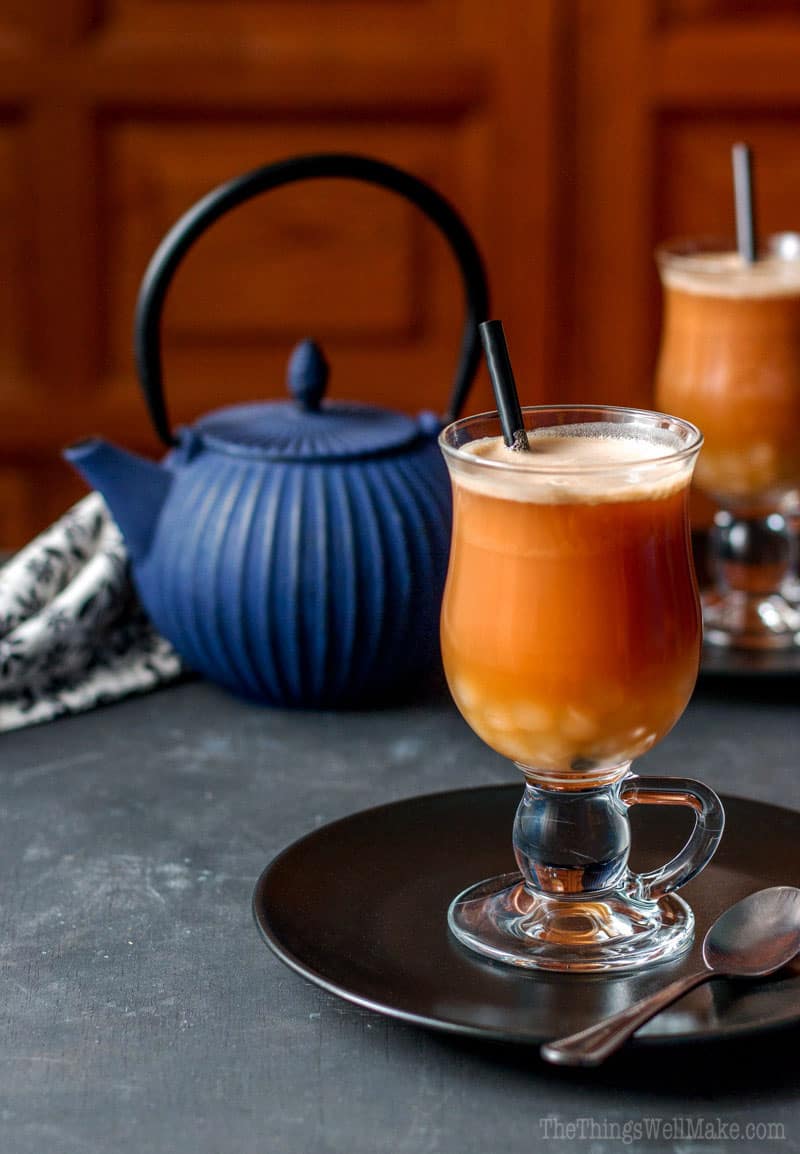
In the middle of the summer heat, you may have noticed that I haven’t been posting as often lately. In part it’s due to my new philosophy of blogging. In part it’s due to having my son home for the summer, and him wanting to play with me most of the day. (I can’t be complaining about having to play in the pool and cuddle up with a sweet, adorable little 5 year old, can I?)
Mostly, though, it’s due to me not being completely caught up from my trip to the US a few weeks back. Amidst the fiestas here in my town, lots of birthday parties and being a full time mommy, it’s taking me longer than I expected to get back into the swing of things.
The first week of our adventures in the US, we stayed at my dad’s house in Connecticut, not too far away from good old New York, New York.
Most of that week was pretty relaxed, but we did manage to throw in a fun day of exploring NYC which included a delicious meal in Chinatown. I had been to NYC as a kid, but don’t remember ever visiting Chinatown, so it was a new, fun adventure for me. I loved marveling at the Asian style architecture of normally American styled places like Starbucks, and if I hadn’t been trying to travel lightly while walking the city, I probably would have bought a few kilos of Asian fruits like lychees, mangosteen, dragon fruits… all of the fun fruits that I can rarely (if ever) find here in Spain.
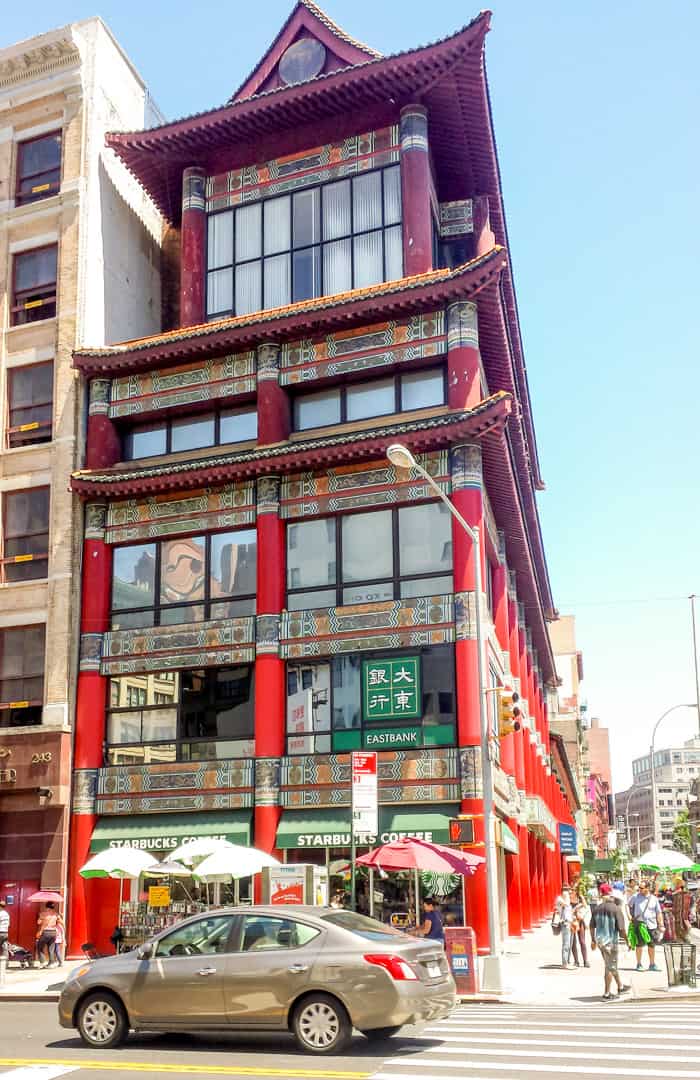
Another delicacy that I wasn’t able to try was boba bubble tea.
After our meal, I eyed the bubble tea for sale at the shop across the street, and hinted at perhaps going over to get some dessert. Normally I don’t go for buying specialty teas and coffees outside the house because I know they’ll be sugar-laden and definitely not paleo. 😉 How often am I going to get the chance to try bubble tea made in Chinatown Manhattan, though, right?
Unfortunately, everybody else was full, except for my boring practical husband who had no interest in trying something as absurd as bubble tea, so in the interest of not drinking alone, I decided to pass and never got to try bubble tea before heading on towards Times Square and Central Park.
Fast forward a few weeks, and I was hanging out at the Asian store here in Spain, browsing all the fun, unusual treats the shop had to offer, and I saw tapioca pearls for sale. I couldn’t help but buy some to make boba at home so that I could try to make homemade bubble tea.
The problem with store bought tapioca pearls
Unfortunately, despite having watched numerous videos and reading numerous blogs about how to cook the darn things, I couldn’t get the store bought boba to cook right!
After some research, I’ve found that it’s probably because the people who have the most success with store bought boba use tapioca pearls that have been sealed in shrink wrap and that need to be stored in the fridge and used up within a week once opened. I’m guessing those are packaged without being completely dehydrated, making their reconstitution easier later on. I have only been able to find the fully dried tapioca pearls here, though.
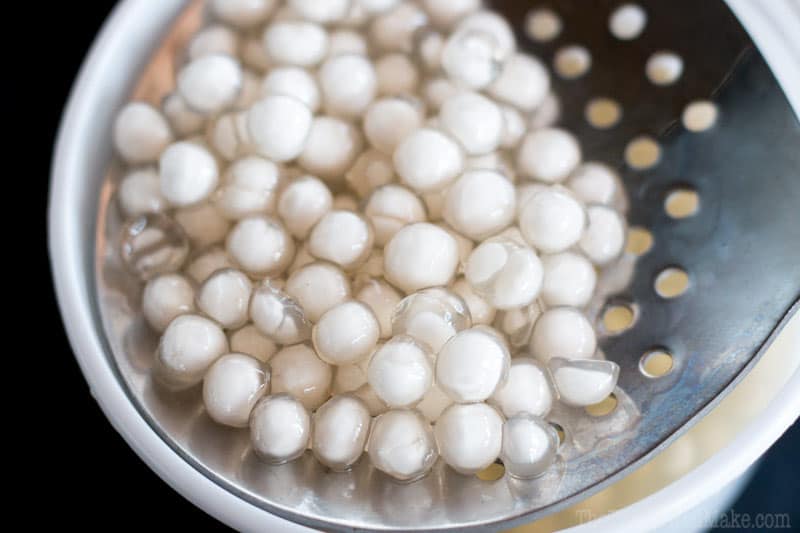
I tried everything from…
pre-soaking the pearls… which ended in a tapioca starch water and powdery mess…
bringing the water to a boil with the boba tapioca pearls already in the pan… which ended up with a gluey mess and no pearls to be seen…
boiling the water and then adding the boba…which, despite boiling for over an hour ended up with rubbery, transparent balls with an opaque, raw, hard, tapioca flour center. Yuck!
The only thing that sort of worked was to boil for very long periods, followed by very long periods of cooling, usually followed by boiling and cooling again at least once more. Even the boba that almost cooked all the way through (see the picture below) weren’t very appealing, and I decided to give up on making homemade bubble tea!
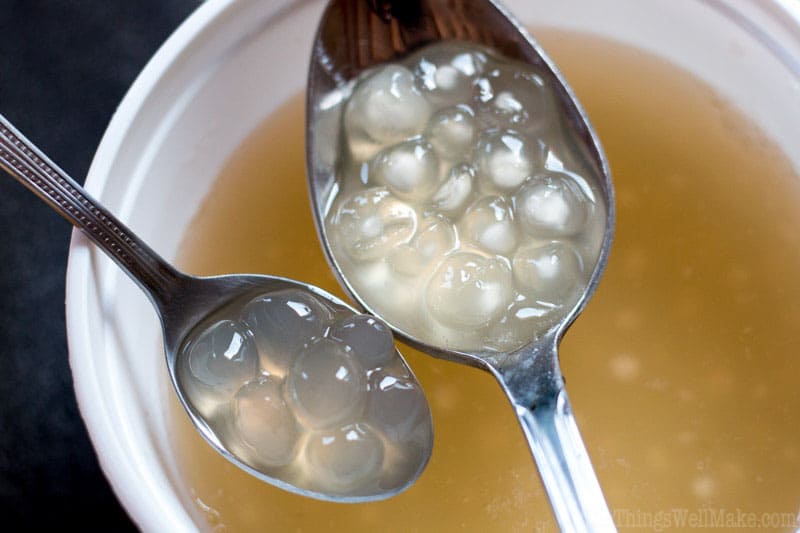
Or did I?
The tapioca pearls that I bought showed only 2 ingredients: tapioca starch and water.
Making tapioca pearls/boba from scratch
Making boba from scratch can’t be that difficult, right?
I thought about how I used to always make pasta from scratch. People used to think I was crazy when they heard that I always made my own pasta from scratch.
Doesn’t that take forever?
Well, actually, no!
Apart from the clean up, it took me about the same amount of time to make homemade pasta as it did for me to boil the store bought stuff. Plus, mine was just so much better and fully customizable!
Why is homemade pasta and boba so quick to make?
Faster cooking time
Because store bought pasta has been dehydrated so that it will keep for longer. Boiling it to cook it takes much longer than cooking the pasta that you have freshly made.
I no longer make homemade pasta very often; not because it takes too long, or because it’s not great, but because most of the time I have completely eliminated gluten from my diet. I have tried coming up with gluten free and grain free pasta recipes, but so far the closest I’ve come to a paleo pasta is the dough I used in my paleo dim sum recipe. (It actually tastes very similar to pasta, and has a similar texture once cooked, it’s just a lot more delicate to work with so it’s not as practical for making something like spaghetti.)
My logic, though, was that homemade boba tapioca pearls would cook similarly. Because they are fresh and haven’t been dehydrated, they would cook up almost immediately.
And I was right!
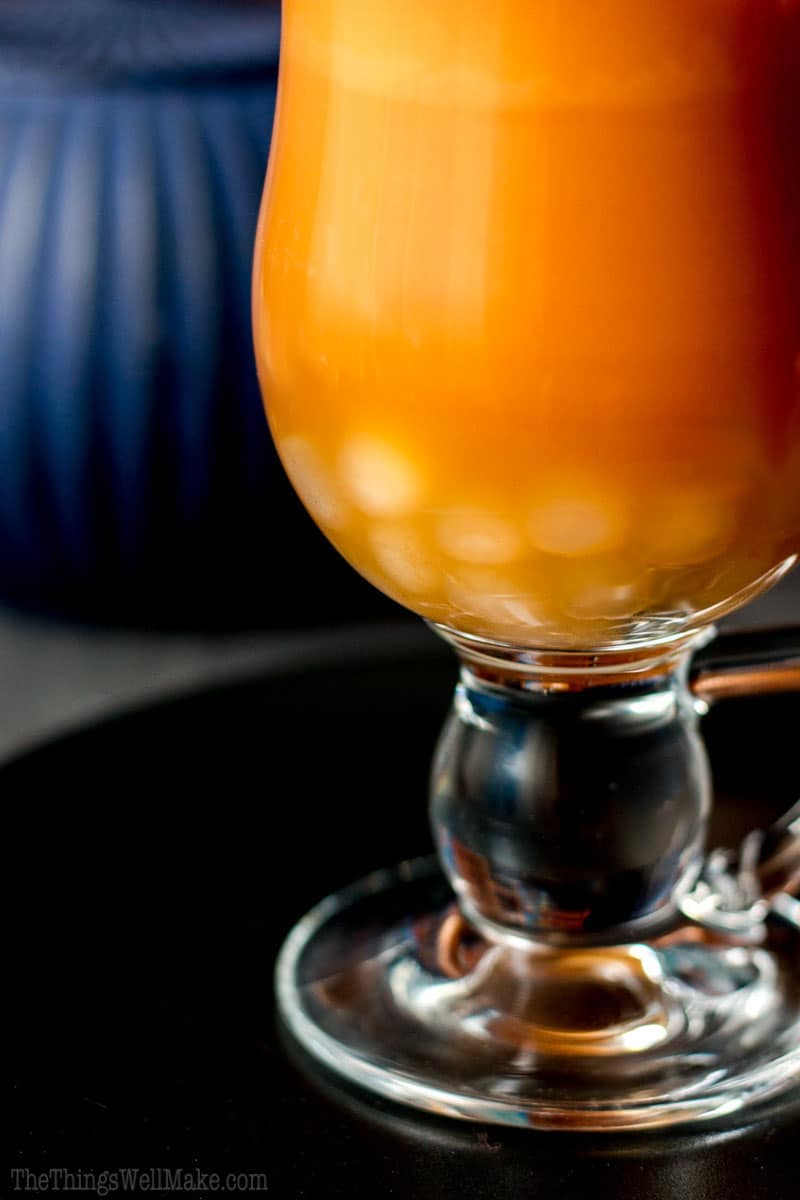
It took me less time to make boba tapioca pearls from scratch than it did for me to try to cook the store bought boba!
Seriously!
It’s super quick and easy to make, and it’s actually even kind of fun.
Plus it uses only 2 ingredients, tapioca starch and water, so it’s gluten free, grain free, and, thus, arguably paleo. 🙂
After me having thrown out some of his dried up, unusable playdough, my son was only too happy to help make little tapioca pearls too. Win-win!
(I may or may not have actually used his.) 😉
Wow, I’m chatty today…
Let’s get to it!
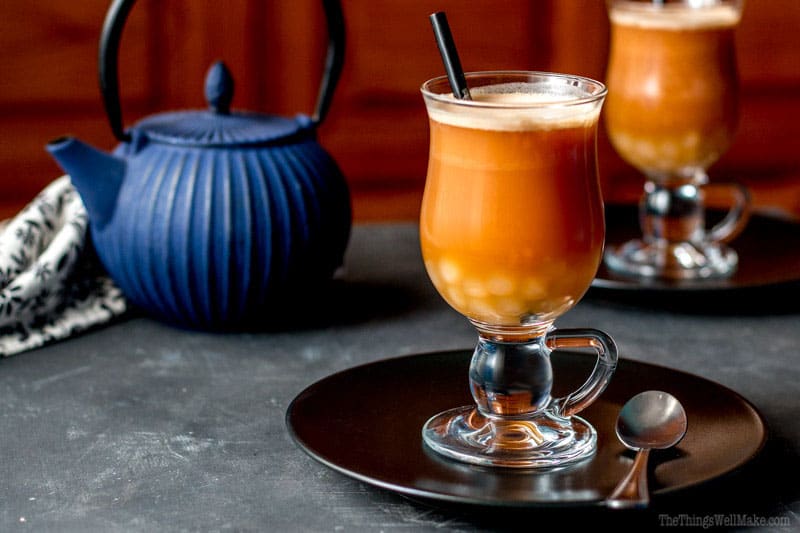
Video
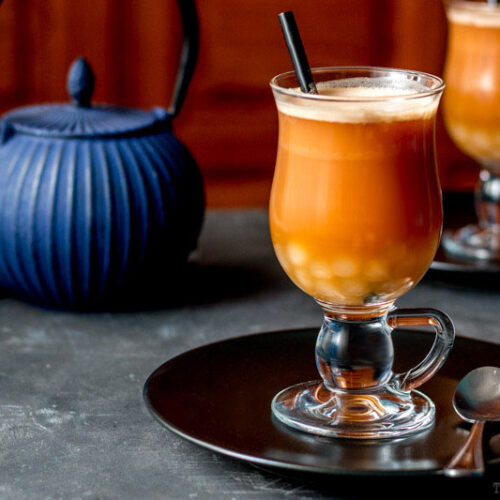
Boba, aka. Tapioca Pearls, From Scratch
Instructions
- Boil the water.
- Add the tapioca starch to a bowl, followed by the boiling water. I work the water in little by little in case it isn’t all needed. Kneading with your hands is the best way to incorporate the water and make a non-sticky dough. Be careful not to burn yourself, though.
- Once you have a workable dough, the easiest way to make tapioca pearls is to roll the dough into long snakes of dough, cut them into small pieces and roll them into tiny balls.
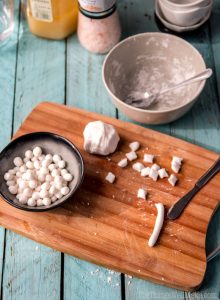
- To cook your homemade boba, boil at least twice as much water as the volume of tapioca pearls that you are going to cook.
- Add your homemade boba to the boiling water. The boba should float to the top. When that happens, turn the heat down to medium
- You’ll notice that the boba begin to cook and get their chewy texture almost immediately. At any point after a couple of minutes, you can use the boba and they will be better than the dehydrated store bought pearls. I later found, though, that if you keep simmering until they fall back to the bottom of the pan, and then remove them, they will be more transparent once removed and allowed to steep in honey for a few minutes. (They will still be pretty opaque when you remove them from the water, but they start to become translucent once removed from the boiling water and stored in honey.)
- Remove the boba from hot water with a slotted spoon, and transfer them to a bowl with some honey. The honey will help preserve them until you are ready to use them, slightly sweeten them, and keep them from sticking to each other.
- Add them to your tea! I’ve found that they have the best texture when warm, so if you want cold bubble tea, it’s best to add them first to your glass while they are warm, and pour the cold tea over top, serving immediately!
- Enjoy!
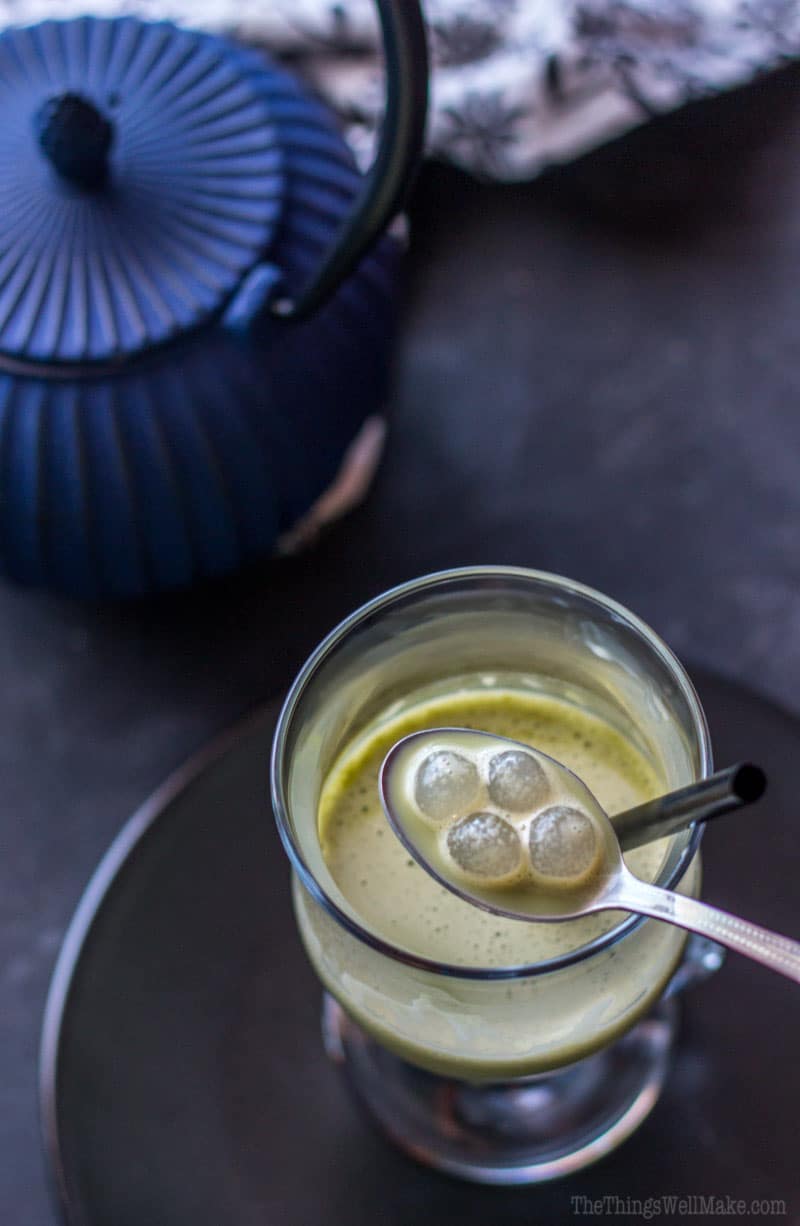
Can you store homemade boba tapioca pearls for later?
I’ve been experimenting with different ways to store them.
Can you let them dry out and then use them later?
Yes, but you end up with the same sort of problem that can be had with store bought dehydrated tapioca pearls. It takes a lot longer to cook them, and you may end up with opaque, raw tapioca flour centers.
Can you freeze the cooked boba?
You can, but they will get opaque and hard. I found that out the hard way when I thought it was a good idea to make popsicles with boba! Some people swear that boba popsicles are great, but I can’t imagine how! I found the frozen boba to be unpalatable and hard. No more boba tea popsicles for me! (I did find one blog post that said that you had to use mini pearls in popsicles for them to stay chewy, but I found the frozen boba to be so gross that I probably won’t be giving it a try!)
If you boil them again, they will warm up and turn translucent again. The texture will come closer to the original chewy texture, but I didn’t find them to be as pleasant as the ones made from scratch and served immediately.
Can you freeze the tapioca pearl dough and form the boba later?
Freezing the dough works pretty well, but the dough can get a bit crumblier and harder to work with once it thaws than when it was freshly made. The cooked boba made from frozen dough seemed pretty much identical to the boba made fresh, so if you get sick of making boba in the middle of the process, freezing the excess dough is definitely an option. I wouldn’t personally make a big batch just to freeze it, though, as it is easy enough to make when needed, and the fresh dough is easier to work with.
Can you freeze the formed, uncooked tapioca pearls?
Yes, and I’ve found that to be the best way to make boba ahead of time and store them for later. They may not turn out exactly like the ones made from scratch, but they are pretty close.
I boil them right from frozen, and boil them a little bit longer than I normally do with freshly made tapioca pearls.
Can you color and flavor homemade boba?
So far, I’ve only tried adding in a pinch of salt and some honey to my homemade boba. They turned out well, and may have been slightly sweeter than the ones that are only soaked in honey, but I didn’t really notice much of a difference in the final outcome. The flavor didn’t really change too much.
A lot of people have asked me about how to make black boba.
So, I began to research the topic. At first, I was pretty sure that the black boba just added food coloring to the boba. That’s probably still the case with most inexpensive black boba for sale. (As you probably know by now, I’m not big about adding colorants to my homemade food, so I haven’t tried using food coloring yet.)
That said, other commenters have brought other theories…
Black sugar
Some people have told me that the difference is that the black boba use dark sugar. There is even a type of Asian sugar called “black sugar” that many have claimed is used in black boba. That said, I’m still of the belief that no matter how much dark sugar was added to the boba, it wouldn’t be enough to make them black!
They may use black sugar in the boba, but it it likely supplemented with some other colorant to make them the deep shade of black that you’re used to seeing in shops.
What does seem more plausible, is another theory offered by readers…
Activated Charcoal
It has been brought to my attention that sometimes activated charcoal is used. One reader saw a video on Facebook showing how activated charcoal was used to make black boba from scratch at a café.
Other colors…
I’ll probably try adding things like matcha or substituting the water with fruit juices in some of my next batches, and I’ll try to keep you updated on the outcome.
I’d love to hear what combinations you come up with!
 Español
Español
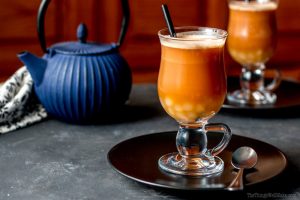
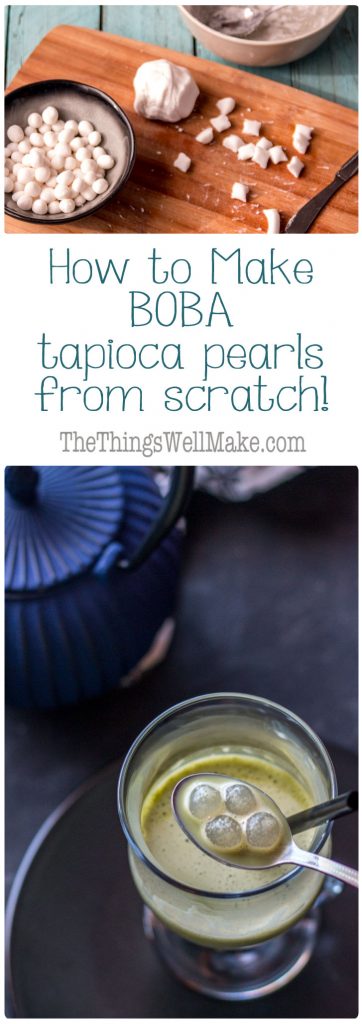
 Best Crispy Kale Chips Recipe
Best Crispy Kale Chips Recipe
Linsey
This recipe worked out amazing… well of course not on the first attempt or maybe not even the second or third attempt lol 🙂 but when i finally get it right the boba were delicious & awesome thank you! 🙂 God Bless!
Tracy Ariza, DDS
Thanks, Linsey! Glad to hear they worked out!
Gerson Bordignon
Para fazer preto use corante de polvo.
Ann
Hi Tracy!
I’ve made tapioca pearls about 8 times now. It’s quite tricky, and time-consuming. After I kneaded the dough, I got about 3 very good little balls. Then the dough quickly became hard and crumbly. Is there a way to keep it soft and pliable?
Thanks!
Tracy Ariza, DDS
Hi Ann,
I’m going to guess that maybe the water wasn’t hot enough. Something about using boiling temperature water converts the tapioca starch into something more elastic and pliable that no longer gets dry and crumbly. It may also depend on the tapioca starch you are using. If you’re sure it’s hot enough and still can’t get it to work, perhaps try a different brand of flour/starch.
Js
Perfect and best to use Organic tapioca flour!
Tracy Ariza, DDS
Of course! Thank you!
Elle
Just commenting about the “honey is toxic when heated” post. The link they shared explains how, when heated, honey creates a non-excreteable genotoxic compound that is beneficial to human health and the lists the good things it does for the body, eg anti-allergen, antioxidant, anti-inflammatory, etc… Honey does not become “toxic” in the sense that is it bad for you. It was really stressing me out to think people might read that post and then stop using honey i things like tea or oatmeal because of a mix up with the words “toxic” and “genotoxic”.
In other news, try using espresso powder for black boba. It works for me, and goes great in iced coffee. And regular food coloring works pretty well, too. Currently have rainbow boba in the fridge waiting to be cooked.
Tracy Ariza, DDS
Awesome! Thanks, Elle for the suggestion and the explanation!
The espresso idea is brilliant!
Dana
i added a teaspoon of vanilla powder and a tablespoon of chia seeds to this. Turned out great!
Tracy Ariza, DDS
Sounds delicious. I’m glad it worked out for you. ☺️ Thanks so much, Dana, for the rating!
Ibu Ku
Could I use tapioca flour (not cassava flour) instead of tapioca starch for this recipe?
Tracy Ariza, DDS
Yes, they are just different terms for the same product. Cassava flour, however, tends to be different as it tends to include the full dried tuber that has been ground into a flour. Tapioca starch/flour normally only has the starch.
Sylvia K
I think honey should not be heated at all, even for sweetening hot beverages, otherwise it becomes toxic. This applies not only to honey, but to all liquid sweeteners (e.g. agave). You have pobably heard of the Maillard reaction, acrylamide formation, HMF? (see e.g. https://www.researchgate.net/publication/324260445_5-Hydroxymethylfurfural_HMF_levels_in_honey_and_other_food_products_effects_on_bees_and_human_health)
This is why I would try cooling down the freshly cooked boba in water before transferring them to the honey…
Greetings!
Tracy Ariza, DDS
Great! Yes, that works fine too.
They aren’t that hot by the time I put them in the honey, so I wasn’t too worried about it, but…
Lately, I’ve been using either maple syrup or a fun new product I bought, coconut syrup. (I think it’s basically just a simple syrup made with coconut sugar.) I love the flavor of both of those. 😉
Sara
This worked brilliantly! Thank you so much!
I am intrigued to try the dark pearls (using muscavado sugar is the plan if I can find it), but these are just perfect as is! (My first attempt with another recipe was a horrible fail so I was reluctant to try again and delighted with the result. 🙂
Tracy Ariza, DDS
Hi Sara,
Thank you! I’m glad you enjoyed them.
I ended up using activated charcoal to make some black boba and also used other powders to make other colors. Did you see the post for colored boba?
I should update this one and link to it, I guess. 😉
Angelina
My “dough” is taking a long time to solidify. Whenever I mix it, it’ll clump up but then liquify again. Did I do something wrong?
Tracy Ariza, DDS
Hi Angelina,
The problem is likely that the water wasn’t hot enough. You need to use water at boiling point or it won’t slightly cook the tapioca starch. If it’s cold, it makes more of an oobleck slime. 😉
Angelina
Thanks! It worked the second time 🙂 I want to make it again, but I ran out of tapioca flour, does cornstarch or all-purpose flour work?
Tracy Ariza, DDS
Hi Angelina,
I’m not sure what you’d end up with either flour- but it would definitely be different from regular boba.
Lisa
I just made brown sugar boba this weekend, using muscovado sugar. It does indeed turn them black, or very nearly. And the brown sugar makes them very tasty.
Tracy Ariza, DDS
Hi Lisa,
Thanks for the tip!
Did you see my post for colored boba? I ended up making black boba with some activated carbon. I also made a bunch of other colors.